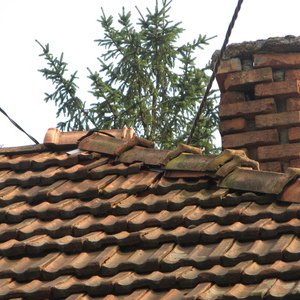
Home appraisals evaluate a home’s competitive position in the real estate market. An appraiser’s opinion of value represents the culmination of a market analysis that compares one home against at least three other similar homes. Appraisers consider a home’s overall wear and tear to evaluate its effective age. As such, an old roof could negatively influence a home’s effective age, but a new roof could simply signify normal maintenance and not significantly affect a home’s appraised value.
Competitive Real Estate Market
Appraisers do not scrutinize a home for defects in the same way a home inspector does. However, if they notice maintenance issues such as a roof that needs replacing, they will weigh that as an economic factor when comparing it with other homes. An old roof puts a home at a competitive disadvantage in its real estate market. Since buyers can view a roof when they drive by a house, they may rule the house out without ever viewing its interior. Appraisers account for this type of choice by adding and subtracting value for a home’s overall condition.
Normal Maintenance
Replacing a roof falls into the realm of preventative maintenance. Once the roof fails to protect a home from water damage, repair costs can mount to include interior damage. According to Mack Strickland, an appraiser in Chester, Virginia, a home that demonstrates a lack of preventative maintenance can lose 10 percent of its value. On a $200,000 home, the deferred maintenance adds up quickly to $20,000. A worn roof alone may not cause an appraiser to devalue a home, but if he notices a number of maintenance issues, they will add to the home’s overall effective age.
Economic Life
A home’s effective age expresses numerically the number of years an appraiser expects a home to survive, or its economic life. For example, a 75-year-old home could have an effective age of 30 years if its owner has maintained the home and upgraded it so it compares well with a new home. Upgrades, such as a new kitchen, walk-in closets and a master bathroom help the older home compete with newer homes. In contrast, a 45-year-old home that has not received proper maintenance may show an effective age of 60 years. Appraisers use the effective age to calculate a home’s depreciating value. Preventative maintenance slows the rate of depreciation.
Maintenance Costs
In general, don’t replace your roof to increase your home’s value. According to LendingTree, you should expect to spend up to 3 percent of your home’s value each year on routine maintenance. If your home is older, that number could go up as you replace some of the major items, such as a roof. LendingTree recommends regular roof inspections to check for loose shingles, suggesting repairs before water can seep into your home. Asphalt shingles have a lifespan of 12 to 25 years.
References
Writer Bio
This article was written by PocketSense staff. If you have any questions, please reach out to us on our contact us page.
